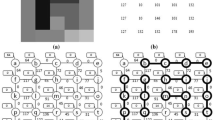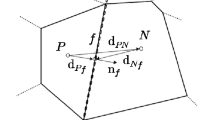Abstract
In this paper a parallel implementation of Meyer watershed algorithm, which does not construct watersheds between catchment basins [2, 10], is developed. A single program multiple data (SPMD) approach is used. Although the watershed algorithm is highly sequential, we have found that much parallelism can be exploited in a loosely coupled system by dividing the task to a set of processes supervised by a master process. Specialized flooding and communication methods have been developed for an efficient parallel computation of watersheds.
Access this chapter
Tax calculation will be finalised at checkout
Purchases are for personal use only
Preview
Unable to display preview. Download preview PDF.
Similar content being viewed by others
References
S. G. Akl, The design and Analysis of Parallel Algorithms, Prentice-Hall International, Inc., pp. 3–29, 1989.
S. Beucher and F. Meyer, “The morphological approach to segmentation: The watershed transformation,” in Mathematical Morphology in Image Processing, E. R. Dougherty, Editor, pp. 433–481, Marcel Dekker Inc., New York, 1993.
P. Chaudhuri, Parallel Algorithms-Design and Analysis, Prentice-Hall International Inc., pp. 37–39, 45–60, Sydney, Australia, 1992.
B. P. Dobrin, T. Viero, and M. Gabbouj, “Fast Watershed Algorithms: Analysis and Extensions,” in IS&T/SPIE Proc. of the Symposium on Electronic Imaging: Science and Technology, vol. 2180, pp. 209–220, San Jose, California, February, 1994.
B. P. Dobrin, T. Viero, and M. Gabbouj, “An Improved Split-and-Merge Watershed Algorithm,” accepted to ISMM, Fontainebleau, France, September, 1994.
A. Geist et al., PVM 3.0 User’s Guide and Reference Manual, Technical Report ORNL/TM12187, Oak Ridge National Laboratory, Feb. 1993.
K. H. Hoffman and Jun Zou, “Parallel efficiency of domain decomposition methods,” Parallel Computing, vol. 19, pp. 1375–1391, North-Holland, Dec. 1993.
C. Lantuejoul and F. Maisonneuve, “Geodesic methods in quantitative image analysis,” Pattern Recognition, vol. 17, no. 2, pp. 177–187, 1984.
F. Meyer and S. Beucher, “Morphological segmentation,” Journal of Visual Communication and Image Representation,vol. 1, no. 1, pp. 21–46, Sept. 1990.
F. Meyer, “Un algorithme optimal de ligne de partage des eaux,” in Proc. 8e Congres Reconnaissance des Formes et Intelligence Artificielle, pp. 847–857, Lyon, France, Nov. 1991.
Author information
Authors and Affiliations
Editor information
Editors and Affiliations
Rights and permissions
Copyright information
© 1994 Springer Science+Business Media Dordrecht
About this chapter
Cite this chapter
Moga, A.N., Viero, T., Dobrin, B.P., Gabbouj, M. (1994). Implementation of a Distributed Watershed Algorithm. In: Serra, J., Soille, P. (eds) Mathematical Morphology and Its Applications to Image Processing. Computational Imaging and Vision, vol 2. Springer, Dordrecht. https://doi.org/10.1007/978-94-011-1040-2_36
Download citation
DOI: https://doi.org/10.1007/978-94-011-1040-2_36
Publisher Name: Springer, Dordrecht
Print ISBN: 978-94-010-4453-0
Online ISBN: 978-94-011-1040-2
eBook Packages: Springer Book Archive




